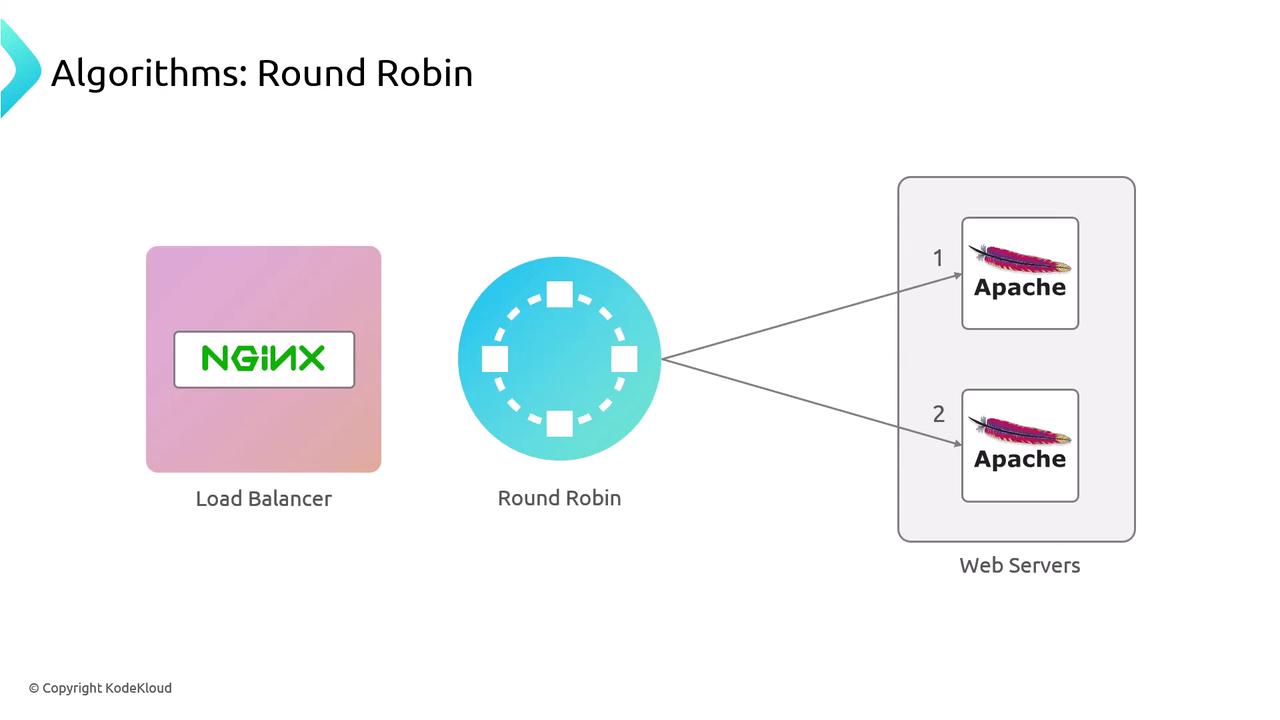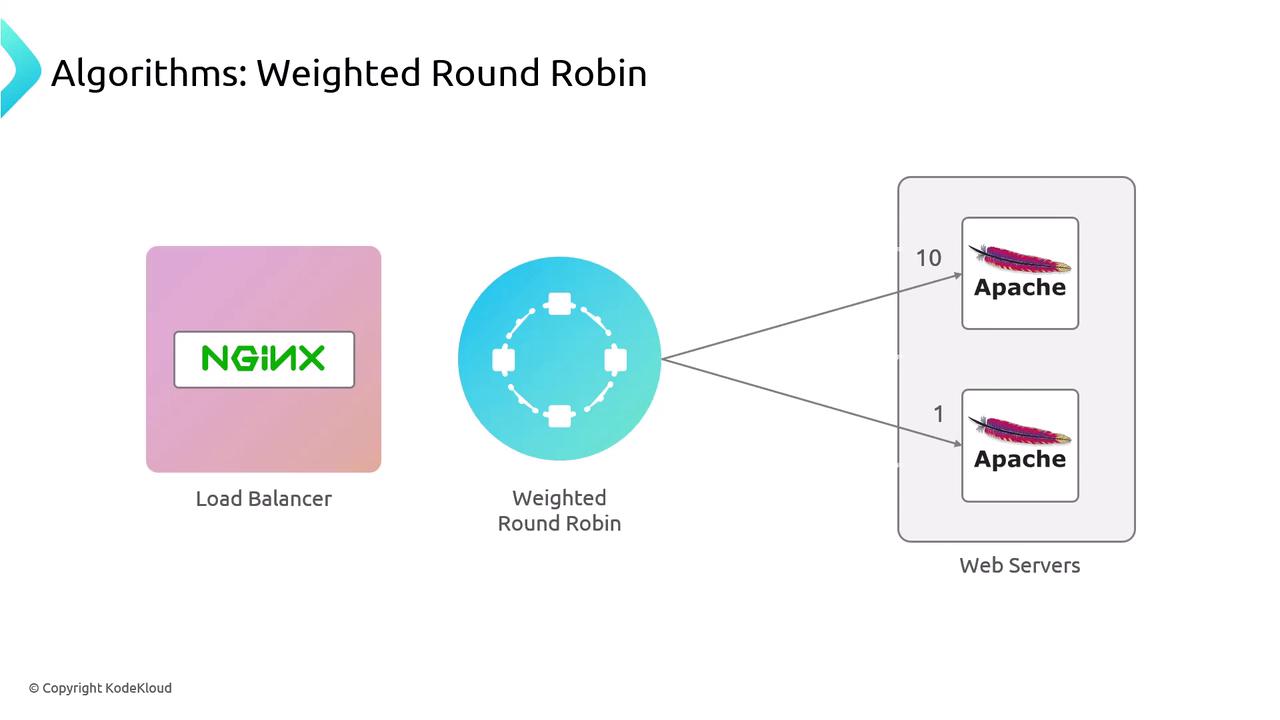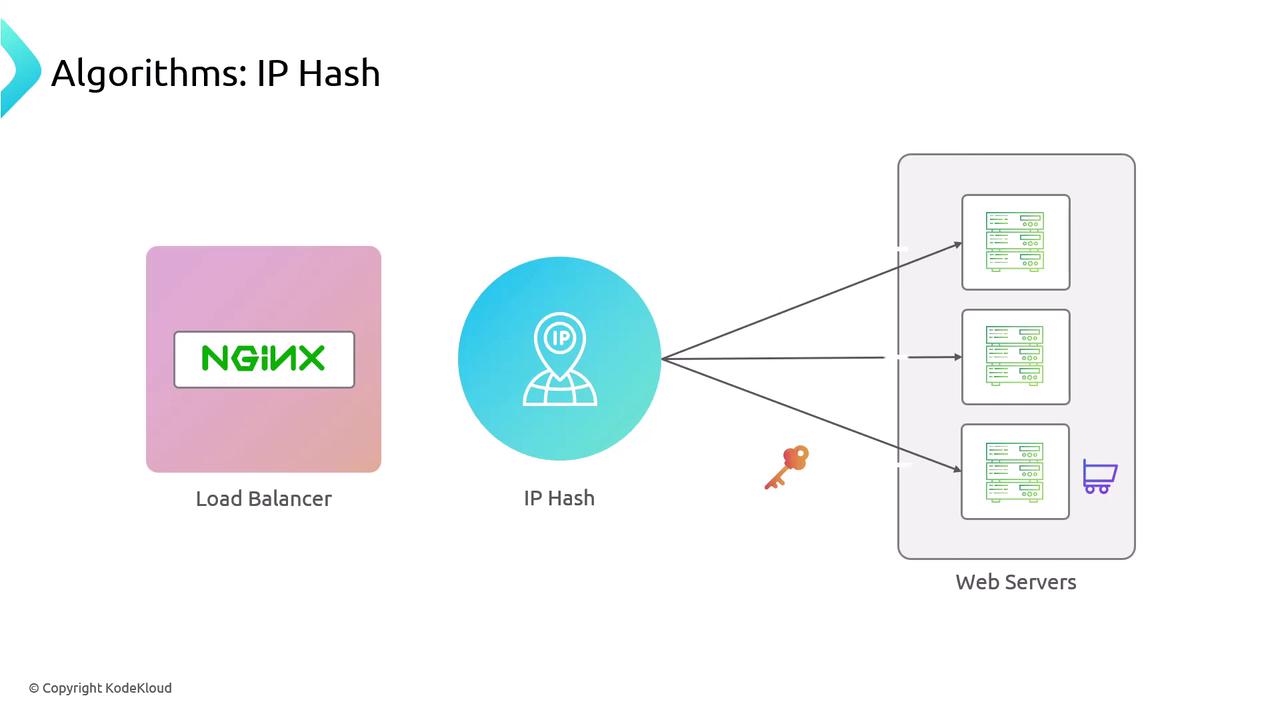Nginx For Beginners
Intermediate Config
Demo Load Balancer
In this tutorial, you'll learn how to configure Nginx as a load balancer using three common algorithms:
- Round Robin: Distributes requests evenly across all backend servers.
- Weighted Round Robin: Assigns traffic proportionally based on server weights.
- IP Hash: Routes each client IP to the same backend to maintain session persistence.



Load Balancing Algorithm Comparison
| Algorithm | Behavior | Use Case |
|---|---|---|
| Round Robin | Cycles through all servers equally | Simple distribution without session affinity |
| Weighted Round Robin | Traffic proportionate to configured server weights | Differing server capacities or performance levels |
| IP Hash | Routes same client IP to the same backend | Session persistence without cookies or headers |
Environment Setup
We have three Ubuntu nodes in our test lab:
- nginx: Nginx load balancer (192.230.202.10)
- node01 & node02: Apache backend servers
On each backend, Apache is running and UFW is active but only port 22 is open by default:
# On node01 (repeat on node02)
root@node01:~# systemctl status apache2
● apache2.service - The Apache HTTP Server
Active: active (running) ...
root@node01:~# ufw status
Status: active
To Action From
-- ------ ----
22/tcp ALLOW Anywhere
22/tcp (v6) ALLOW Anywhere (v6)
Allow Only the Load Balancer
For security, restrict HTTP access so only the load balancer (192.230.202.10) can reach port 80 on your backends.
# On node01
root@node01:~# ufw allow from 192.230.202.10 proto tcp to any port 80
# Verify the rule
root@node01:~# ufw status
Status: active
To Action From
-- ------ ----
22/tcp ALLOW Anywhere
192.230.202.10 80/tcp ALLOW Anywhere
22/tcp (v6) ALLOW Anywhere (v6)
# Repeat on node02
root@node02:~# ufw allow from 192.230.202.10 proto tcp to any port 80
Configuring the Load Balancer
On the nginx node, create or edit your site configuration:
root@nginx:~# cd /etc/nginx/sites-available/
root@nginx:/etc/nginx/sites-available# vim apache-app
Start with a basic server block:
server {
listen 80;
server_name apache.example.com;
root /var/www/html;
# Default index files
index index.html index.htm index.nginx-debian.html;
location / {
try_files $uri $uri/ =404;
}
}
1. Round Robin
Add an upstream block for your backend pool:
# Upstream (Round Robin)
upstream apache_example {
server 192.230.202.12:80;
server 192.230.202.3:80;
}
server {
listen 80;
server_name apache.example.com;
root /var/www/html;
index index.html index.htm index.nginx-debian.html;
location / {
proxy_pass http://apache_example;
}
}
Enable the site and reload Nginx:
root@nginx:/etc/nginx/sites-available# nginx -t
root@nginx:/etc/nginx/sites-available# ln -s apache-app /etc/nginx/sites-enabled/
root@nginx:/etc/nginx/sites-available# nginx -s reload
Test with curl to see alternating responses:
root@nginx:~# curl localhost
<p>Served by node02</p>
root@nginx:~# curl localhost
<p>Served by node01</p>
2. Weighted Round Robin
Adjust the upstream block to assign server weights:
# Upstream (Weighted Round Robin)
upstream apache_example {
server 192.230.202.12:80 weight=10;
server 192.230.202.3:80 weight=1;
}
Reload Nginx to apply:
root@nginx:~# nginx -s reload
Now about 10× more requests go to the higher-weighted server.
3. IP Hash
Enable ip_hash for session stickiness by client IP:
# Upstream (IP Hash)
upstream apache_example {
ip_hash;
server 192.230.202.12:80;
server 192.230.202.3:80;
}
Reload Nginx:
root@nginx:~# nginx -s reload
Consistent Routing
With ip_hash, each client IP always hits the same backend server. This is ideal for stateful applications.
You can extend this setup with health checks, SSL termination, or alternative Nginx modules.
Links and References
Watch Video
Watch video content
Practice Lab
Practice lab